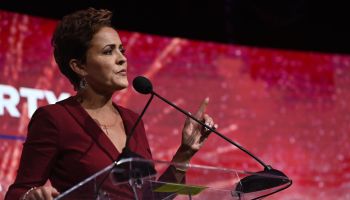Following is a guest review of “12 Years a Slave” by writer Pearl Duncan.
For the first time, a movie about slavery, prominently and unapologetically, highlights not only how American whites enslaved their own children, grandchildren and relatives who were biracial and multiracial, but how the enslaved people tried to escape. Enslaved people in America resisted. How that resistance is perceived depends on who is viewing.
This ain’t no “Gone With the Wind.” The cast of the movie, “12 Years a Slave,” appeared at the preview I saw at the New York Film Festival. Steve McQueen, the filmmaker, shook hands and greeted us as we stood online to enter the theater. His film showcases the spiritual side of freedom, hard work and struggle, which are captured beautifully in the musical soundtrack of Negro spirituals, hymns and colonial work songs. There is no question that there is a new approach in how the history of this American colonial era is captured in art.
SEE ALSO: The True Story Of ’12 Years A Slave Hero,’ Solomon Northup
This singular classic creation of a movie opened in New York, Los Angeles, Washington, D.C., Atlanta, Chicago and Toronto on October 18; in other cities over the weekend; will open nationwide on November 1, and in the U.K. on January 24.
There is a new pulse to the history in this movie about slavery in America. The powerful actors in a movie, produced by Brad Pitt’s production company, starring Chiwetel Ejiofor as the hero, Solomon Northup; Michael Fassbender as Edwin Epps, a sadistic slaveowner villain; Lupita Nyong’o as Patsey, an abused young woman; Brad Pitt as Samuel Bass, a Canadian abolitionist and carpenter; Alfre Woodard as the black common-law wife of a slaveowner, mistress of the house who has made her choice, and Sarah Paulson as Mrs. Epps, the white wife of slaveowner who let her emotions reach the boiling evil level, elevate the true history. The performances are so powerful and the theme so dynamic, the question is, Will we leave this movie feeling uplifted and inspired? When Solomon Northup looks the audience in the eyes in a gaze that lingers on the screen, his eyes ask, What do you do now? Is this the true history you knew?
McQueen and his film won the People’s Choice Award at the Toronto International Film Festival; attendees voted the director and film into first place, and movie critics have said this is an Oscar contender. Here, I review the memoir on which the film is based and simply say, go see this movie. The filmmaker captures the spirit of freedom, so here, I also review the yearning for freedom and escape, as described in the book, the hero’s personal memoir from 1853.
In the book, the lead character in this story, born a free man, knows his own genealogy, and he recounts the genealogy of other enslaved men, women and children. But as the story progresses, we see that this story is more personal, because it is an inside view from the fibers of the minds and hearts of those who lived it, of practices historians deemed, “the peculiar institution,” but practices which were beyond peculiar. Ancestry is something some enslaved African Americans did not know, or were too haunted by violence to discuss. In this story, the hero, Solomon Northup, names names. He shows that the violence in the slavery era, something he calls, demonic, was up-close and personal.
The book’s full title is “12 Years a Slave: Narrative of Solomon Northup, a Citizen of New-York, Kidnapped in Washington City in 1841, and Rescued in 1853, From a Plantation Near the Red River, in Louisiana.” The work and now the powerful film confront the contradictions of bondage as lived by a nation, slaveowners and enslaved people.
As a person who researches and writes, not only as a historian but as a genealogist, I am drawn to the work, as I was to Lee Daniels’ “The Butler” and Quentin Tarantino’s “Django Unchained,” as I was to “Roots” and “The Biography of Miss Jane Pitman” and so many of the movies that preceded the present ones. Art informs history. This is a story of large themes. Kidnapped. Name changed. Transported to different places by different means. Sold and resold to different owners. Struggled to survive in a desolate, haunting landscape among people with sociopathic sensibilities. As readers and viewers, we know, if a person’s family and friends could not find their loved ones in colonial times, how can a modern genealogist. For me, the most haunting scene was when Solomon was free and the others were left behind. Their lost and untold stories must be told.
In the years of colonial America, abolitionist authors influenced opinions about slavery, freedom and liberty, and stirred the debate of whether enslaved African Americans cherished freedom. Art influences history, but some historical realities are not well-known.
This movie portrays the personal nature of slavery, and the maroon spirit of the enslaved, even those who were trapped on plantations. I’ve said we have to view this history from the point-of-view of specific Maroon groups, whose names are noted with a capital M, who liberated themselves, as well as the maroons, the people trapped on plantations, for they too sought freedom. The hero, Solomon Northup, says “There was not a day throughout the ten years I belonged to Epps [a drunken, sadistic owner who whipped his slaves incessantly] that I did not consult with myself upon the prospect of escape.”
Like the Maroons, Northrop and the others viewed slavery from the perspective of free people. He describes what they tried to escape. In his memoir, he describes the demonic obstacles mounted against anyone trying to escaping: “Every white man’s hand is raised against him – the patrollers [mounted and armed] are watching for him – the hounds are ready to follow on his track, and the nature of the country is such as renders it impossible to pass through it with any safety.” Filmmaker Steve McQueen said he wanted the movie based on the true story to feel like science fiction as much as history.
I am interested in hearing from and knowing if the Blacks and whites descended from the range of characters portrayed know who these ancestors were, these people who were our ancestors: African Americans who resisted and rebelled; enslaved people who defied, resisted and ran away; greedy people who profited from human bondage; abolitionist whites who assisted slaves to escape to freedom, sadistic and opportunistic whites who battered enslaved black people; abolitionists and enslavers who had children with the enslaved. I wondered about these ancestors and whether any of their DNA or their spirit survives in us now.
I read “12 Years a Slave” with the thoughts of a genealogist running through my head. Solomon Northup, a family man, farmer, homeowner and talented violinist in upstate New York who was tricked, lured from his home, kidnapped, beaten and enslaved, who wrote the memoir in 1853, about whose life, struggles, triumph, and freedom the movie is based, thought like a genealogist too. The filmmaker Steve McQueen is also a genealogist; he too, of England, descended from enslaved people in the Caribbean island in Trinidad, traced his ancestors to slaves and slaveowners.
After Northup’s 12-year ordeal, being beaten and tortured as a slave, he said, “Hundreds of free citizens have been kidnapped and sold into slavery, and are at this moment wearing out their lives on plantations in Texas and Louisiana.” There were thousands of free people who were kidnapped and chained, millions of their African ancestors who were kidnapped, bought, sold and enslaved. I wonder if their descendants know specifically who they are.
These books and movies are a call, a spiritual beacon, for anyone who hasn’t done genealogy to review the new information in this art and start to find the ancestors. In Saratoga, New York, Solomon Northup’s descendants meet every year to celebrate the Solomon Northup Freedom Day. (On Monday, October 21st, after a premiere of the movie in Northup’s hometown region, the Underground Railroad History Project of the New York Capital Region in Albany hosted a discussion by Northup’s descendant, his great-great-great-grandson, Jamie Adams.)
Genealogists, readers and historian know that enslaved people were skilled craftsmen and women who brought various skills to their slavery experiences. In Northup’s era, he was referred to Northup as a talented violinist, as he refers to himself, but I noticed that reviewers of the era also referred to him as a fiddler. He referred to his instrument as a violin or a fiddle. He described his life as a farmer, a free man, in upstate New York. He says “In the winter season I had numerous calls to play the violin. Wherever the young people assembled to dance, I was almost invariably there. Throughout the surrounding villages my fiddle was notorious.” African American fiddlers were prevalent in Colonial America. I capture them in my upcoming book about the 18th-century merchant cargo ship discovered under the World Trade Center in 2010.
It warms the heart to read Northup who says of the freemen who were fiddlers, “We always returned home from the performances of these services with money in our pockets; so that, with fiddling, cooking, and farming, we soon found ourselves in the possession of abundance, and, in fact, leading a happy and prosperous life.” The movie’s soundtrack will capture the African American musical experience: John Legend, Alicia Keys, Hans Zimmer, Alabama Shakes and others will add to a soundtrack, which will be released in mid-November.
Music provided solace, emotional escape and sounded resistance for slaves and free people. As a descendant of Maroons, I focused on Northrup’s and the others’ resistance. The writer of the introduction to the edition of Northup’s book, historian Philip S. Foner, observed that, “Like Frederick Douglass, Solomon Northup whipped his overseer and was involved in two near-rebellions.” Northup said the woods and swamps of Louisiana were “continually filled with runaways.” Slaves and free people clung to whatever defined them as human, as citizens.
New books and movies are adding a new narrative to the mainstream narratives. It is important that the ancestors and the narratives that have been left out of history be acknowledged. One story that has been hard to portray, although it is encrypted in the DNA of Americans is how much slavery was a coming together of violent beatings and sexuality. This movie, personal and up close, lays bare that narrative in the story of the relationship between Patsey and the slaveowner, Edwin Epps.
“12 Years a Slave” is not only a movie about a free African American and his enduring experience as a slave, it is also about whites who enslaved their own children, and knew that their own children and relatives were enslaved.
It is also a story about the maroon-thinking of freedom and escape of the slaves and their awareness of their genealogy, despite their silence in the torturous environment. That is what the book and the movie portray, when viewed from the perspective of a genealogist. In the book and the movie, the lead character, Solomon, says his father’s paternal ancestors were African slaves; he does not say what his father’s maternal ancestors were, but we know they were African. He says his mother was a quadroon, which means she had one black grandparent and three white ones.
His wife, he says, in her origins was red, white and black, “she cannot properly be styled a quadroon.” His father was a slave who was freed in his owner’s will when his owner died. The whites who were his father’s and his mother’s relatives and his wife’s relatives knew they had relatives who were slaves. But freedom was not guaranteed even when an owner on his deathbed emancipated his slave. Northup recounted the story of Eliza, who was emancipated in her owner’s will, who has a biracial child by her owner, but the owner’s white daughter sent her to Washington in the guise of registering her freedom papers, but instead sold her into slavery. That daughter sold her own relative, her own half-sister into slavery. Northup was born a free man.
The memoir was a personal tour-de-force, because Northup reflected philosophically on what he had experienced. I recap that experience and philosophy by reviewing the history as it was reflected in his memoir, according to its full title: “12 Years a Slave: Narrative of Solomon Northup, a Citizen of New-York, Kidnapped in Washington City in 1841, and Rescued in 1853, From a Plantation Near the Red River, in Louisiana”
If anything in this review moves you, you must see the movie, which opens, directed by filmmaker Steve McQueen, produced by Brad Pitt’s company, with Chiwetel Ejiofor’s Solomon Northup as the leading hero, and Michael Fassbender’s Edwin Epps as the leading villain. Northup’s epic memoir was edited by David Wilson of New York in 1853 and adapted for the screen by John Ridley. His account was supported by documentary evidence. His narrative is as dramatic as that of a master cultural observer and narrator, because he describes his experiences and reflects on the institution of slavery, reflecting on the practices historian call, “the peculiar institution.”
Narrative of Solomon Northup, a Citizen of New-York, Kidnapped in Washington City in 1841: Northup’s portrayal of his experiences is so personal, in his memoir when he is taken to Washington, drugged and realized he is kidnapped, he says, “I felt there was no trust or mercy in unfeeling men.” He handed himself to “the God to the oppressed.” He describes the isolation and psychological loneliness the slaves felt not only in the country but in the universe. He also paints a picture of what the slaves felt about the men and women and the country that allowed such inhumanity, describing the men who kidnapped and enslaved him as “subtle and inhuman monsters in the shape of men.”
Enslaved, confronted by a slavetrader, in a slave pen in the cellar of a residential building in Washington, in a “slave pen within the very shadow of the Capitol!” confined, he said the pen was “like a farmer’s barnyard.”
within plain sight of this same house, looking down from its commanding height upon it, was the Capitol. The voices of patriotic representatives boasting of freedom equality, and the rattling of the poor slave’s chains, almost commingled.
In the cellar, in the barnyard, as he declared that he was a free man, not a slave, he was beaten into submission, whipped repeatedly with “instruments of torture,” with a hardwood paddle board, a cat-o’ninetails, a larger roped board, “bored with a small auger in numerous places,” with “many strands – the strands unraveled, and a knot tied at the extremity of each. Feet fastened to the floor, he was stripped of his clothing, draped facedown over a bench, his wrists tied, and whipped by two simultaneously different henchmen. McQueen brings these scenes to life in dramatic sequences.
The up-close and personal view is what gives the narrative its dramatic power. There will be more narratives in the future, because as powerful as his account is, he names some villains but not all, for he says he does not know all his kidnappers and enslavers, “whoever they might be, as unmitigated villains.” From the other slaves, he learned that the place where he was bore the name, William’s Slave Pen. Of the beatings he said, “My sufferings I compare to nothing else than the burning agonies of hell.”
The torture on the plantations was worse.
He describes them in detail and names their names when he is sold at an auction block in New Orleans, and sold and traded to various slaveowners. These names are not fictional, they are historical. Describing the torture in the cellar in Washington, he said, “he plied the lash without stint upon my poor body, until it seemed that the lacerated flesh was stripped from my bones at every stroke.”
His rescue was as dramatic as his enslavement was historic. When he was kidnapped and transported from upstate New York to Washington, D.C., his kidnappers deceivingly but historically accurate suggested that he obtain free papers from the Custom House and clerk’s office because he was traveling from a free state to a slave one. The reverse trip, after 12 years, from a slave state to a free one held much trepidation. He was totally dependent on his own rebellious spirit, his desire for the freedom he knew long ago, and the kindness of others.
Northup’s narrative of his ordeal is dramatic, even before he reaches the auction block and the plantations in Bayou Boœuf, Louisiana. It was no illusion he said.
Thought was busy in my brain. Could it be possible that I was thousands of miles from home – that I had been driven through the streets like a dumb beast – that I had been chained and beaten without mercy – that I was even then herded with a drove of slaves, a slave myself? Were the events of the last few weeks realities indeed?
The movie answers these questions. From the beginning of his ordeal, his thinking and actions were like a maroon. The movie depicts slavery but it also has all the elements of maroon thinking and actions. First, what Toni Morrison calls rememory. He was lucky enough to know who his ancestors were, and he remembered. Many slaves were children who had no knowledge of their parents. He remembered that his father “endeavored to imbue our minds with sentiments of morality, and to teach us to place our trust and confidence in Him who regards the humblest as well as the highest of his creatures. . . . How often since that time has the recollection of his paternal counsels occurred to me.” When he rebelled, he was driven by this memory.
Escape was always on his mind and he made several escape attempts. “I was almost resolved to attempt to break away. Had I not been hand-cuffed, the attempt would certainly have been made.” He was handcuffed to Eliza, a mother and her children and a small boy as they left Washington, D.C. under the cloud of darkness. The slave auction scenes and the breaking up of families, the separation of Eliza from her children Randall and Emily are heart-wrenching. Solomon Northup, now renamed Platt, was purchased by a minister slaveowner. The movie is a study in character.
These were people who showed that they brought special skills to the plantations; they brought the knowledge from the places where they had lived, where they had been stolen. Northup on the first plantation showed his knowledge of building river rafts, a skill he had learned as a free man earning a living working on the canals of Lake Champlain in New York. He and other skilled laves plotted their escape, before they were absorbed deeper into the slavery institution, away from civilization. With instincts like this to be free, that is why my Maroon ancestors rebelled on slave ships and as soon as they landed.
Trust was crucial, because the slaves had to sort through the vile enslavers and the trusting fellow travelers through life to determine who, to trust. Enslaved, he trusted a sailor on the ship Orleans en route to New Orleans and entrusted him with a letter to the lawyer, Henry B. Northup, about his kidnapping, because, “The tone and manner of the man assured me.” The benevolent sailor was John Manning, an Englishman who lived in Boston. Henry B. Northup, upon receiving the letter, could not determine specifically where Solomon Northup was.
Rescue was also a crucial emotion and action, but it was not as easy. They strategized their rebellions and escape. He was always thinking of escape, and planning. He spoke of “my right to freedom” and of escaping to “the soil of freedom.”
Dangerous as it was, resistance was common. When his second owner, whom he called a “blasphemous tyrant” demanded that he stripped to be whipped, he told us, “I had made up my mind fully not to be whipped, let the result be life or death.” He responded to his owner, whom the law said could do anything to his flesh: “Master Tibeats, said I, looking at him boldly in the face, ‘I will not.’”
And finally, names were crucial, and he remembered his given name when he was renamed Platt by the slavetraders. We too need to remember the renaming of these ancestors when we do genealogy. Solomon Northup, a supplicant, begged for strength and mercy “on high to bear up against the burden of my troubles.” They mustered their strength and survived and be maroons. Eliza’s name was changed to Dradey in the slave records of the office of the New Orleans recorder. Ancestors who preserved their names as nicknames resisted; anyone who finds ancestors who preserved their names under these conditions must be very grateful.
These ancestors, Solomon Northup and others who were enslaved were maroons who plotted to survive, whether they escaped or endured. The book’s factual scenes of demonic torture made me wonder how a director handles such scenes in a movie. All I could think is there are more books and films to come. Revenge. Retaliation. Rebellion. Reconciliation. Redemption. The torture scenes will be interrupted by a militia of armed Maroons who descend on the plantation to rescue the tortured, as they did in reality in some parts of the Americas, where the terrain allowed them cover.
His description of the terrain in relation to escape and plans remind us that place and terrain made such a difference in escape plots, resistance and rebellions.
The fictional “Uncle Tom’s Cabin,” a fictional antislavery novel by Harriet Beecher Stowe (1852), became a standard on our reading lists and in our school curriculum, and the factual memoir, “12 Years a Slave,” by Solomon Northup (1853), dropped from view and memory. Both were bestsellers in pre-Civil War years. I revisited Northup’s memoir, because his book should be replaced on our reading lists.
He had the strength to fight, yet remain moral in a place in America’s age of inhumanity and immorality — and write about his experiences. He built allies. The question is, What are we doing? Have we evolved as freedom fighters?
Pearl Duncan, writer and historian, is completing a book about the 18th-century merchant cargo ship discovered below the streets of New York in the foundations of the World Trade Center in 2010, and another about the worldwide uniqueness of African American DNA and ancestry.
















